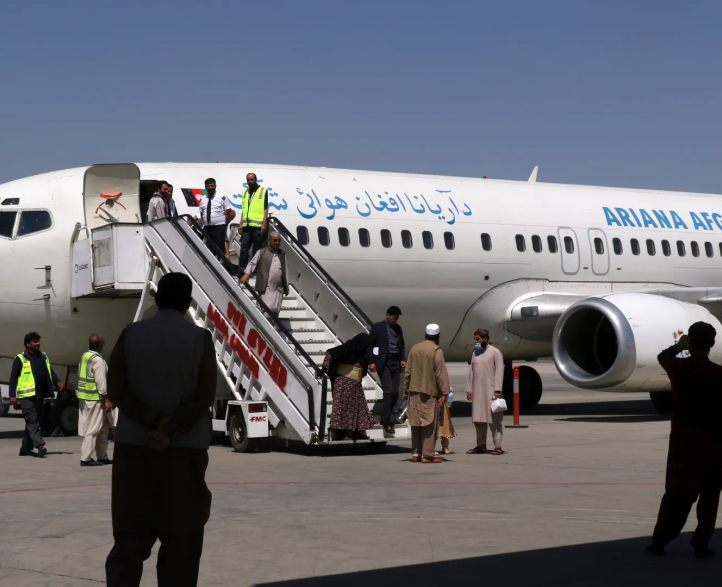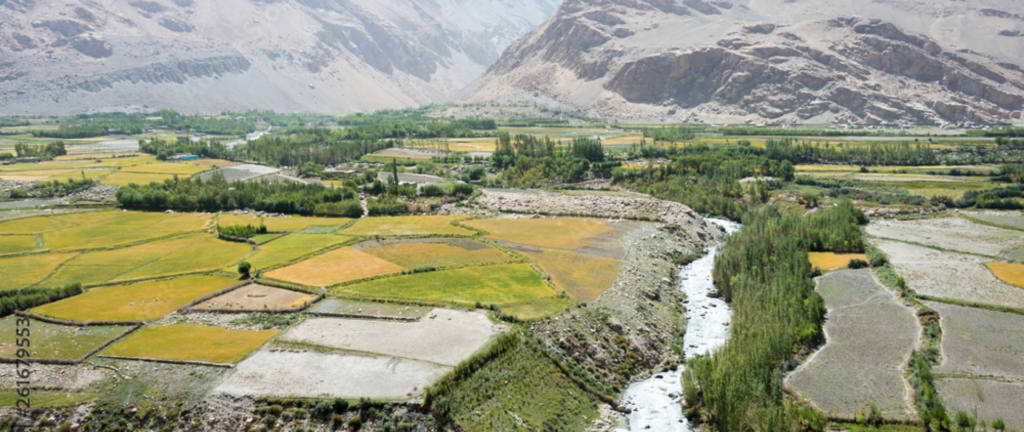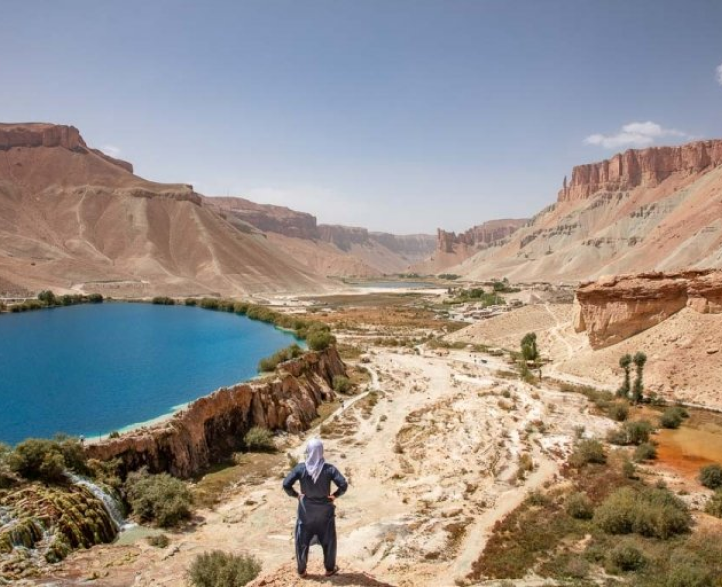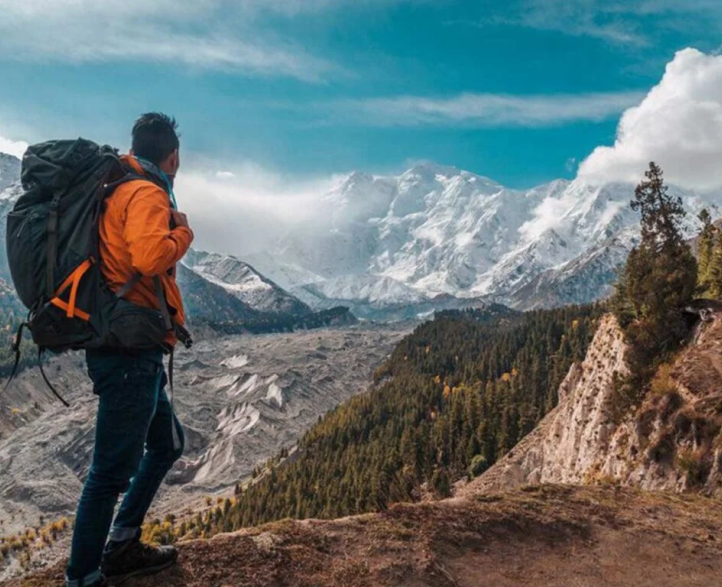
Afghanistan is a country in Asia with a land area of 652.000 square kilometers and a population of 35 million people. It shares a border with China of 75 kilometers, Tajikistan of 1200 kilometers, Uzbekistan of 137 kilometers, Turkmenistan of 744 kilometers, Iran of 930 kilometers, and Pakistan of 2400 kilometers.
There are 34 provinces in Afghanistan and it has a lot to visit, but only 6 provinces are comparatively open for tourism due to security concerns. Even within these six provinces, however, there is no guarantee of safety since the Taliban and other armed groups are involved, occupying roughly 55% of the region. This Afghanistan guidebook intends to provide you with the necessary details for exploring the areas that we consider to be reasonably secure.
Islam is the most widely practiced religion in Afghanistan. 70% of Sunnis and 21% of Shias are among the 99 percent of adherents, 4% are the Ismailis, whereas the other 1% are followers of other faiths like Sikh, a few Christians and a Jew!
As a result, Sunni Islam is Afghanistan’s official religion (Hanafi). The Hazara tribal are home to the majority of Shias, who live in provinces such as Bamiyan, Daikondi, Ghor, and Ghazni in central Afghanistan. Despite being persecuted, the Hazaras have proven to be the most prosperous tribe in Afghanistan throughout history.
The Ismailis also known as the followers of the Aga Khan, who currently resides in Portugal and won numerous pluralism, peace building and humanitarian services awards/prizes including the Nobel Prize, are the modest and liberals who do not believe in violence and extremism. In the northeastern parts, their territories have never experienced wars till this day. You may have heard of the infamous Wakhan Corridor too.
YES, the region is already a war zone, and things have gotten worse over the last two years after foreign forces left and ISIS’ Khorasan branch declared its presence in the country. You would be able to fly to a few provinces if you take adequate security measures. Continue reading to find out where in Afghanistan it is possible to go.
We are also asked if solo female travelers have a chance wondering lonely? The immediate answer is a big fat NO. For most parts it is advisable to travel with a companion, but for the Wakhan Corridor, Ishkashim and the beautiful Shughnan districts of Northeast Afghanistan, you have a clear green light!
For furthermore security measures and mitigating risks while traveling in Afghanistan visit our RISK METIGATION SECTION.

There are several airlines that provide flights to Afghanistan in various configurations. There are no direct flights from Europe or the United States, so you’ll have to stop in a hub like Istanbul, Dubai, Doha, or Abu Dhabi. There are several low-cost flights to Afghanistan with companies like Emirates and FlyDubai, but they normally come with long layovers that make the trip 20-30 hours long. Turkish Airlines also flies to Afghanistan, but their flights are shorter and more costly.
Your choices for traveling to Afghanistan by land (Check with a foreigner and/or a trustworthy local tour guide/operator)
Don’t attempt to/from China. They will put you away for a month or two.
Tajikistan has a long border and many customs offices including;
Other than the ShirKhan Bander the others are completely safe, although we suggest only Shughnan, Ishkashim and Wakhan. You will need separate Wakhan Permit if you are entering it and simple registration for Ishkashim and Shughnan.
Uzbekistan, from Hayratan to Mazar e Sharif – Recommended only with a highly reliable source.
Turkmenistan, from Torghundi port in Herat and Aqina in Faryab Province – Not Recommended
Iran, Islam Qala Port – Recommended only with a highly reliable source.
Pakistan, Torkham port in Nangarhar – Recommended only with a highly reliable source.
No other points, not at least we know of, are safe for now.
Air travel to Afghanistan: what are your options? (Recommended)
A few Afghan cities have international airports, and this is the safest way to enter the country.
Flights to Afghanistan normally land in one of the following cities:
As you will see, there are several options for getting to Afghanistan, both by land and by air. The choice you chose is determined by where you are and where you want to go in Afghanistan. For example, if you want to travel the Wakhan Corridor in Badakhshan, you may only enter by land from Tajikistan or we can fly you with a chartered flight, there is no road from Kabul to Mazar Sharif, or Kunduz is currently too risky, as the Taliban often set up checkpoints and ask for everyone's papers and conduct passenger searches in the hunt for government officials or security forces. So, you can say foreigners might be at even greater risk.
Herat Province shares a border with Iran, which is 110 kilometers west of Herat City, and with Turkmenistan, which is 110 kilometers north. The province of Balkh shares a border with Uzbekistan, which is crossed by a bridge 80 kilometers north of Mazar-e-Sharif. While we don't suggest entering by land because some merchants have been abducted on the highways and the Taliban occasionally set up checkpoints on the major roads, the borders of these two provinces are comparatively safer and you have the option to reach Afghanistan from them.
How do I get an Afghan visa?
If you want to visit Afghanistan, you must apply for a visa just like every other destination.
Just those who are formally invited by businesses or officials from other nations, but not visitors, are granted visas on arrival at Kabul airport. To obtain an Afghan tourist visa, you must first complete the form available on the websites of the Afghan foreign ministry and Afghan embassies.
Keep in mind that visitors can only get a one-month visa, but this can be extended to three months in Afghanistan at the Interior Ministry office in Kabul or at police headquarters in the province's major cities.
If you have any concerns about the procedure, contact the embassy directly; they are very polite and supportive. If that doesn’t answer your call, send us your passport copy and we will ARRANGE YOUR VISA.
Afghan Visa Requirements
The following papers must be shown to the embassy in order to obtain an Afghan visa:
Afghanistan packing list
Water Purifier. If you do drink tap water, we highly advise you to use a water purifier since fresh water in many provinces is unhealthy to drink due to the contamination of a large number of toilet and irrigation wells dug too close together. Just drink bottled water purchased from a store, not from street stalls. If you really must drink tap water, invest in a water purifier.
Shoes that are easy to walk in. Since the infrastructure and highways are in such poor shape, and the streets are rough and filthy, we suggest that you forget about beauty and fashion and bring a pair of covered comfortable shoes with you if you wish to visit Afghanistan (preferably runners).
Dress modestly. Women should cover up in public— a hijab and long dress at a minimum. It’s best for men to also wear the ‘Shalwar Kimiz’ while in more rural areas. In most cities, a tunic like this will suffice; however, in some places, a chador might be needed to avoid attracting unwanted attention; you will have to choose for yourself if you are uncomfortable.
Protect yourself from the sun. From spring to fall, sunblock is essential when visiting Afghanistan, as the weather is hot and dry in most areas. In Afghanistan, we would recommend a sunblock with an SPF of at least 50.
Moisturizer. Afghanistan has no sea or ocean connections, and the country is mostly mountainous and at a high altitude, so the climate is exceptionally dry. This type of climate will make you look like an oldie in a month. Since you're wearing sunscreen throughout the day, we recommend a deep, nourishing night cream.
Power Banks. The voltage converter and a universal power socket adapter Form C and F power sockets are used in Afghanistan, and the normal voltage is 220. As a result, we suggest bringing a universal power adapter and a voltage converter with you while visiting Afghanistan.
Activated Charcoal. In Afghanistan, if you're smart of what you eat and where you eat it, you'll be fine and won't have to waste hours vomiting your guts, unlike in some of the other countries. Activated charcoal, on the other hand, is also recommended because it can assist with dehydration and food poisoning.
Mosquito net is recommended. While you wouldn’t need vaccinations, it's a smart idea to bring a mosquito repellent and a mosquito net with you to avoid any unpleasant surprises. They are simple to use and are particularly useful in the summer and fall
There are several tribes in Afghanistan, each with its own language, while Tajiks and Pashtuns are the two largest ethnic groups. Pashtuns speak Pashtu, and Tajiks speak Farsi/Dari, but Farsi is the most widely spoken language in this country since it is spoken by all tribes except Pashtuns, including Hazara, Uzbeki, Turkmani, and others. Since few people speak English, learning some useful Farsi phrases and carrying a small English-Farsi travel book are valuable tips for planning a trip to Afghanistan.
Classic Afghan attire
There are too many different clothing styles for women of almost every province. Kaala e Tajiki and Gand e Afghani are the most famous clothing for women. Women's Afghani clothing varies in price and size. Many considerations come into play, like the tribe to which the Afghani dress you chose belongs. Afghan men's clothing is almost similar in all places over Afghanistan for all tribes and can be purchased ready-made or custom-made to your exact measurements from a tailor. It takes a day or two to complete, and the fabric as well as the tailoring fee will cost up to $15. Men also had a Pakol and/or scarf to the suit. They have been mostly used for the dry weather but now it’s become a style.
The AFGHANI is the Afghan currency. One US dollar equals 78 Afghani, while one Euro equals 86 Afghani (UPDATE April 15, 2021). But in far away villages and mountains, the prices will be less, something like 3 to 5 Afghani less than the cities.
We suggest not carrying too much cash because your ATM cards will operate in Afghanistan and you will be able to withdraw up to $2000 USD a day from an ATM. If you need to convert your dollars to Afghani, you can do so at the airport or in the larger cities. There are men, who can be seen keeping money in the city centers of many provinces. They usually offer a decent exchange rate, but it's better to use some local contacts.
In Afghanistan, cash is the best way to pay because stores lack a point of sale, so you can't use your credit card. Some stores in Kabul have started to accept credit cards now.
Afghanistan has four seasons and is a mountainous, dusty, and windy region. Summers are hot and dry, while winters are bitterly cold. Cold winters and humid summers are made intolerable by a lack of adequate power and gas infrastructure. Furthermore, women must cover a lot of ground, which is much more difficult in the summer.
This is why we suggest visiting Afghanistan in the spring or autumn, when the worst of the cold and heat has passed.
The weather will vary between 10 and 35 degrees Celsius from March to June (spring).
In the summer, temperatures in Afghanistan can reach 35-45 degrees Celsius.
Temperatures range from 10 degrees Celsius to 30 degrees Celsius from September to December (fall).
Afghanistan's winter weather is often below freezing, with temperatures ranging from -5 to -15 degrees Celsius.
In most areas of Afghanistan, the weather is harsh, which is one of the reasons why Afghans age easily.
Afghanistan's Internet and SIM Cards
Instead of paying an additional international roaming fee while visiting Afghanistan, you may want to use a local SIM card for both calls and internet.
Etisalat, Roshan, Afghan Wireless, MTN, and Salam are the five major companies in Afghanistan that have SIM cards and 3G internet.
Sim cards can be purchased for as little as 60-100 Afs in most places. If you're traveling with another individual, we suggest getting an Etisalat and a Roshan because the other one works in areas where the first one doesn't.
Many of the above internet packages have a one-month validity period. Depending on which companies you dial, you will be paid 2-5 Afs per minute to make a call inside the region. If you toggle one of the international call deals, international calls cost about 10-15 Afs.
More details are available at www.roshan.af and www.etisalat.af.
Afghanistan is rich in historical sites to visit, with thousands of years of history. There are caravanserais, ancient bazaars, citadels and forts, palaces, royal gardens, and, of course, a beautiful mountainous landscape in this former Persian empire and vital stop along the silk routes.
Sadly, nearly four decades of continuous fighting have destroyed many sites, and those that remain can no longer be reached because they are either under the control of the Taliban and other militant forces, or have been converted into military posts by the Afghan Army.
Here are some of the areas in Afghanistan that are still safe to visit. For others, we recommend enlisting the help of a local. If you don't know one and are looking for a credible and trustworthy English-speaking guide, please email us and we will provide you with their contact information on a confidential basis.
Kabul, Afghanistan's capital, is one of the cities where the fighting is most palpable. However, this may be the reason why it is difficult to visit Afghanistan without doing so.
Barg Continental restaurant
Slice Bakery
Cafeteria
Shinwari Restaurants around the Shar e Naw Park
Boolani snacks: Many stalls and bread bakery shops in Kabul sell the best vegies, potato and pumpkin boolani, which makes a great morning or evening snack. They're very big, and you will just need one or two for a meal. You can have them fried or baked; the baked ones are lighter in fat, but the fried ones are also delicious. They're truly delectable, so don't pass them up.
If you're visiting Afghanistan for the first time, the historical city of Herat is a must-see.
People refer to it as the city of wisdom and civilization, and local officials may refer to it as Ancient Herat.
After all, this province has thousands of years of history, from before Alexander the Great's conquest to the reign of the Ekhamanshi Emperor. And after decades of fighting, Herat, a vital stop on the Silk Road and a centuries-old center for artists and rulers, has a plethora of things to do.
Many of Afghanistan's tourist attractions are housed in Herat City, so don't forget it. Here are some:
Mazar-e Sharif, the capital of Balkh Province, is a relatively secure region, so it's certainly worth visiting if you visit Afghanistan.
Mazar-e Sharif's blue mosque is the city's most important attraction. It's also known as the Hazrat Ali Shrine, or Zeyarat Sakhi Jan, as locals call it. Ali is the Prophet Mohammad's son-in-law, and Shias regard him as Mohammad's heir. One of the reasons for the division of Muslim adherents into the two major sects of Sunnis and Shias is this assumption. Sunnis consider Ali to be Rashedin's fourth and final Khulafaih (or Hazrat, like Imam but higher position).
While most Muslims believe Hazrat-e-Ali was buried in Najaf Ashraf, Iraq, some Afghans believe he was taken to Afghanistan and is now buried in Mazar-e Sharif's Blue Mosque.
The Wakhan Corridor is a thumb-shaped thin strip of land in Afghanistan that stretches from Tajikistan to China and splits Tajikistan and Pakistan. The Panj and Pamir Rivers emerge from the high mountain valleys here, forming the Amu Darya, Central Asia's most well-known and notorious waterway. The corridor is wedged between the Pamir Mountains to the north and the Karakoram range to the south. River valleys that connect the Pamir, Tien Shan, Karakorum, and Hindu Kush are crisscrossed by rugged, harsh mountains. Kyrgyz and Wakhi nomad herds also exist in the corridor's deepest valleys, living very primitive lives. Because of its remoteness, the region has remained untouched by high-tech technologies and urbanization, making trekking both daunting and satisfying. It is also the second national park of Afghanistan.
The U-formed mountains that provide plentiful munching grass during summer, however, are secured by snow for as long as six months. In the Wakhan, two such enormous zones of meadow, the Big Pamir (Pamir-e- Kalan or Pamir-e-Buzurg) and the Little Pamir (Pamir Khurd or Pamir-e-Kochak) exist. These valleys are utilized by the semi-nomad Wakhi for the summer, who come back to their villages in winter. The Kyrgyz are the permanent residents of the highest altitudes of the Pamirs. Although the Little Pamir is bigger in territory, the Big Pamir, is what makes the corridor popular for visitors and trekkers.
In the infamous Corridor you can spent a life time and still wonder if you have seen all of it or not. We had tourists you stayed in these alpines for THREE MONTHS!
There are a few designed itineraries, then there are tailor-made tours that we would suggest to look for while travelling to the Corridor.

Many provinces in Afghanistan are dangerous to visit due to the highly sensitive situation in Afghanistan right now, with peace negotiations between the US and the Taliban armed group also ongoing.
Since fighting between the Taliban and Afghan forces is still on, you should stay away from the most vulnerable areas. Only the provinces listed above in our Afghanistan travel guide are considered secure at this time. The other provinces are currently too dangerous. Notably, certain destinations are very appealing, and many people have inquired about visiting them. So, if you are very much determined to visit a city of your choice, we mean other than those already listed, please let us secure the way for you.
When traveling to Afghanistan, you must carefully choose hotels that offer basic facilities as well as adequate security measures. Large hotels in major cities normally have websites where you can book your room online; but, if you want to stay in a less expensive location, you can book by going there directly. Simply take a taxi from the airport and show the driver your hotel’s address. Or contact us!
Any of our hotel recommendations are included below.
In Kabul’s Shahr-e Naw neighborhood, there are many budget and mid-range choices. Our hotels of choices for budgeted accommodations are Marco Polo and Salsal.
As you would expect, finding insurance providers willing to insure travel in Afghanistan is difficult. Regardless of the difficulty, getting travel insurance while flying into a third-world conflict zone is a good option.
On Lonely Planet's Thorn Tree travel forums, there's an extremely detailed guide to insurance plans for Afghanistan (and other war zones).
In Afghanistan, the most important aspect of travel is safety! As we say, secure is a relative term, but there are certain steps you may take to lessen the chances of something bad happening to you.
Unless with a local, try to stop wandering around after dark. Avoid driving between cities after midnight, because that’s when the Taliban would come out to set up illegal checkpoints on the roads.
If you need anything after evening and don't feel safe walking outdoors, hotel and guesthouse staff will gladly assist you.
Anything that aids in your blending is a good idea. Even blondes will mix in Afghanistan! It might seem futile, but Afghans are far more varied in color than you would think. Tips on how to dress in the area can be found in the What to Wear list.
Don't go about screaming in your native tongue—it'll draw attention to the fact that you're a foreigner! In Afghanistan, word spreads quickly, and the fewer people know that foreigners are present, the better.
On local buses, this is particularly so. If anyone notices a foreigner on the bus, they can notify a contact ahead of time, who can plan a mishap farther down the track. People are rewarded financially if they turn in others to the Taliban, so be cautious.
Knowing which embassy or consulate you may contact in the event of an emergency is still a good idea. If your country does not have an embassy in Kabul, look for one of your neighbors or allies.
When in Afghanistan, you will notice that before every meal they will bring water or ask you wash your hands and also after the meal. However, this does not imply that it is spotless. Food-borne illnesses are widespread in Afghanistan, so be cautious around mealtimes. Except if you're dining at a higher-end or family restaurant, skip tap water and something made of ice.
While there are several small clinics throughout the cities, a high-quality medical care and a team who speak English, are the Blossom Health Care in Kabul located in Shar e Naw. You will find them on the Google Maps. They're very helpful, speak excellent English, and will give you a discount if you tell them you're just a tourist, not a volunteer.
When it comes to Afghanistan, you want a guide who is unfailing and trustworthy. Send us an email and we'll put you in touch with individual guides in Afghanistan's major cities.










We offer the best value and satisfying tours available in Afghanistan. Depending on your interest visit our numerous cultural tours, expeditions, music and food tours, peak climbing and others to reserves a booking. We prioritize special group tours while cater for regular ones. If these tours do not meet your desires, simply send an email and let us custom design your favorite tour of Afghanistan.
The company will also take care of the requisite security precautions. If you have a particular travel itinerary or need armed guards and armor vehicles in Afghanistan, please let us know and we will assess your individual itinerary. Please contact us directly for pricing and availability, and we will respond with more details on a confidential basis.
